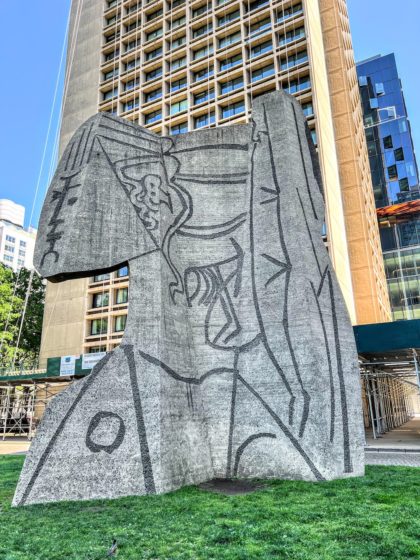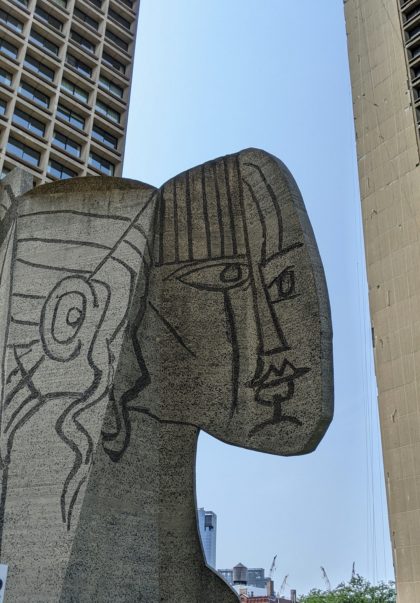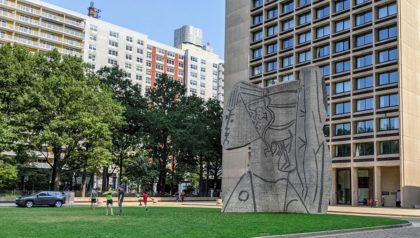Art in (not really) Tribeca: Picasso’s Bust of Sylvette
Artist: Carl Nesjär
Title: Bust of Sylvette
Location: NYU Silver Towers courtyard at 505 LaGuardia Place
Installed by: I. M. Pei & Associates in 1968
Artist bio: Carl Nesjär, a Norwegian painter and sculptor, was Picasso’s chosen fabricator and worked with the artist for 20 years, turning his drawings and models into large public sculptures. Together, the two created more than 30 sculptures, which can be found on the campuses of Princeton, NYU and MIT, as well as in public spaces in Norway, France, Spain and Israel.
Nesjär was raised in Southern Norway and in Bay Ridge, Brooklyn. He studied art at the Pratt Institute, Columbia University, and in Oslo and Paris. Nesjär collaborated with architect Erling Viksjø on a particular concrete sculpting method called Betograve, which Nesjar introduced to Picasso, leading to their lasting collaboration that started in 1958.
Nesjär died in Oslo on 23 May 2015 at the age of 94.
Background: Hidden between NYU’s Silver Towers on LaGuardia Place between Bleeker and Houston stands a 36-foot-tall, 60-ton Picasso sculpture titled “Bust of Sylvette”– inspired by Sylvette David, one of Picasso’s favorite models. I. M. Pei, whose firm was the complex’s architects, originally wanted a large-scale Picasso sculpture for an earlier project in Kips Bay Plaza, but when that plan was opposed, he moved it further downtown — first proposing the corner of Houston and Mercer, and then changing it to the courtyard of the Silver Towers because the sculpture mimics the “pinwheel” layout of the three buildings in the complex.
To etch the dark, textured lines that define Sylvette and many of Picasso’s other public sculptures, Nesjar used the Betograve technique. First, a wooden frame is constructed and filled with dark rock materials; it is then covered with concrete. The surface of the concrete is then sandblasted following a template, revealing the dark material in the lines on the surface.
In 2008, University Village, the five-acre complex that includes the Silver Towers, was named an individual city landmark, as “one of the finest examples of a mid-20th century residential complex located in New York City.” From the designation report:
“Designed by architect James Ingo Freed of I. M. Pei & Associates for New York University, construction began in 1964 and was completed by 1967. Occupying a five-acre ‘superblock’ in Greenwich Village, between West Houston and Bleecker Streets, the site was originally part of a much larger urban renewal scheme conceived by Robert Moses, chairman of the Mayor’s Committee on Slum Clearance, in 1953. As part of NYU’s agreement with the city to take over the site in 1960, the school set aside one-third of the units for middle-income residents.
“The complex includes three identical free-standing 30-story towers executed in reinforced concrete that are positioned at the center of the site in a “pinwheel” configuration around a 100-by-100 foot lawn…Cast in place, on site, using fiberglass molds, these buff-colored towers fall into the general stylistic category known as “Brutalism” and reflect the influence of the Swiss-French architect Le Corbusier, whom Pei admired.
“Near the center of the complex stands a large sandblasted concrete sculpture, an enlargement of a 1954 cubistic work by Pablo Picasso. Executed in 1968 by the French artist’s frequent collaborator, the Norwegian sculptor Carl Nesjar, the off-center placement of the 36-foot tall bust echoes and enhances the project’s dynamic plan.”
~Rose Yardeni


















